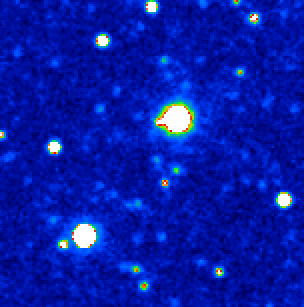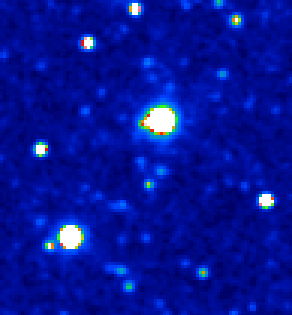A Drizzle Coadder for WIRE
1. Overview
The WIRE focal plane is badly undersampled with 15.5" pixels sampling a
diffraction-limited beam 8-17" FWHM. This is a situation similar to that
encountered with HST/WFPC2. Even with the PC, at short wavelengths a single
PC pixel is considerably larger than the FWHM of the expected PSF. In order to
combat this, Andy Fruchter and other at STScI have developed the "Drizzle"
method of coadding images, taking advantage of the additional spatial
information contained in individual frames which have been dithered by
fractional number of pixels.
The inherent problem with a shift-and-add coadder like that implemented by
the data pipeline is that it convolves the PSF with a top-hat function of the
original pixel size, which in the case of WIRE is similar to the expected
telescope performance.
Drizzle eliminates this problem by reconstructing the data onto an arbitrarily
fine spatial grid. Rather than shifting and adding the original pixels with
interpolation, drizzle shrinks each pixel into a smaller footprint (called a
"drop") and then places them onto the finely sampled reconstruction grid
(hence the name "drizzle"). When the drop size is equal to the original pixel
size, this is equivalent to shift-and-add. When the drop size is made extremely
small, this reduces to interlacing. Drizzle has the added advantage that it can
be used to coadd frames with any geometric relation, i.e. they can be shifted,
rotated, or of different sizes and pixel scales. With the regularity of the WIRE
data, however, this may not be particularly useful. Also, drizzle is known to be
flux conserving.
2. Implementation
I have written a Drizzle coadder for use with WIRE data. It is a series of csh
scripts that borrow heavily from Fruchter's code, pieces of IRAF, and several
bits of homegrown IPAC software. Currently, the software
1. Scans the current directory for all WIRE data.
2. Derives approximate shifts from the image headers.
3. Computes more accurate shifts using cross-correlation and the initial shift
values.
4. Drizzles the data onto a new grid whose shape is user-specified.
There is currently no cosmic-ray rejection.
3. Results
On the right is a simulated pipeline coadd of 40 data frames at 12um. On the left
is the same data coadded with Drizzle using a 9.3" drop size and reconstructed
onto a 5"/pixel grid.
 |
 |
|
Drizzle Coadder |
Pipeline Coadder |
Fortunately the two look very similar! In practice one wants to minimize the
"drop" size, since this minimizes image degradation due to convolution with
the drop size. However, the minimum size of the drop is dictated by the
diversity of sub-pixel image shifts available - a drop size smaller than a typical
shift will result in data gaps in the reconstructed image. In reality the drop
size must be made still larger in order to ensure a sufficiently high amount of
data coverage. Similar arguments hold for the reconstructed pixel size. For 40
frames with the current dither pattern, drop sizes between 6-9" seem to
provide adequate coverage. Given the achieved spatial resolution, the 5" pixel
size seems to provide adequate sampling. Smaller drops may be used in the
future with different dither patterns or more frames.
Results have not been as encouraging as I had hoped. The achieved FWHM at
12um is typically 18-19", which is larger by a factor of 2 than the diffraction
limit, and only slightly better than the pipeline coadder. The apparent
improvement in image resolution is mostly a result of resampling to a 5" grid;
the resulting image is not as badly aliased as that produced by the pipeline.
The mottled appearance of the background is a result of the actual noise being
related to the spatial sampling of the dithered frames and the noise in the
original pixels, which are now mostly decoupled from the physical pixels in
the regridded image. The interpolation and large pixels used by the pipeline
coadder smear this noise.
Update: I have now been working with Andy at STScI, and it appears
that drizzle with sub-pixel dithering will not acheive much more than 19.5" at
12um. However, the images do look quite a bit better, with less correlated noise
in the drizzle image. It now appears that a 7.73" pixel size and a small (0.01)
pixel fraction is the best approach.
4. Performance
In order to test the performance of the source extractor on a drizzled image, I
used 40 frames of simulated data at 12 microns. The pipeline coadder was used
to generate a grand coadd, and the source extractor was applied in order to
generate a basis for comparison.
The frames were then drizzled using a 7.73" pixel size and a 0.01 pixel fraction.
The standalone version of DAOPHOT II was used to generate a new PSF for use
in the source extraction. Wiredao was then run using the same input
parameters as the original source extraction, only using the new PSF and
estimate of the fwhm. The resulting source list was then matched against the
truth list used to create the simuklated frames using the "match4" program.
As was anticipated from looking at the images, the results are nearly
identical. This is not too surprising given then the coadder works in nearly
the same manner as drizzle, but with a pixel fraction of 1. The postscript file
linked immediately above gives detailed information on the completeness,
reliability, and other interesting indicators of performance. The "600" frame is
the drizzle coadd, while the "500" is the survey coadder. Ignore the 12 and 25
micron labels, they are placed there automatically by the "stplot2" program
that generated this output.



